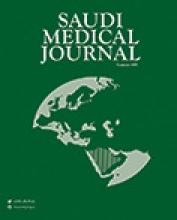Abstract
OBJECTIVE: To identify the clinico-radiological features of patients with positive cultures for nontuberculous mycobacteria (NTM) and compare those to a sample of patients with tuberculosis (MTB).
METHODS: A laboratory database was used to retrieve all specimens submitted to King Khalid University Hospital, Riyadh, mycobacteriology laboratory for mycobacterial smears and cultures during the period from October 1999-April 2002. Using this database, the original records of the mycobacteriology laboratory and a review of the patient's health records, a standard proforma was completed that included demographic, clinical, radiological and laboratory information on patients included in this study. The patients were divided into 2 groups; the NTM group, which included all patients with positive cultures for NTM and the MTB group, which included a sample of patients with documented tuberculosis.
RESULTS: During the study period, 286 patients had positive mycobacterial cultures. Seventy patients (24.5%) grew NTM and 216 (75.5%) grew MTB. For patients with MTB, 54 patients were included as per the selection protocol of the study. There was no difference between the 2 groups in all measured demographic variables. The presence of weight loss and fever was significantly more in the MTB group. Radiologically, the presence of hilar adenopathy was more significant among patients with MTB than those with NTM (17% versus 4%, p=0.02). However, bronchiectatic changes were seen significantly more among NTM patients compared to patients with MTB (26% versus 11%, p=0.03).
CONCLUSION: The isolation of NTM in the mycobacteriology laboratory is high. The clinico-radiological features were not sufficiently specific to differentiate patients with NTM from patients with MTB. Local studies are needed to explore NTM disease in various developing countries and identify the NTM species causing infections in non-immunosuppressed patients in each locality.
- Copyright: © Saudi Medical Journal
This is an open-access article distributed under the terms of the Creative Commons Attribution-Noncommercial-Share Alike 3.0 Unported, which permits unrestricted use, distribution, and reproduction in any medium, provided the original work is properly cited.






